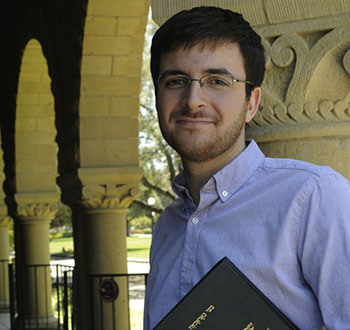
Isaac Bleaman
While most scholars listen to testimony for what survivors say about historical events and personal experiences, Isaac Bleaman studies how they say it.
Bleaman is a second-year doctoral candidate in linguistics at New York University with a master’s in Yiddish Studies from Oxford University. He studies sociolinguistic variation, language contact, language shift and the factors that constrain variation in contemporary spoken Yiddish. He also founded Leyenzal, a non-profit that commissions original video lectures in Yiddish about Yiddish literature.
Last month, he presented his latest research project at the YIVO Institute for Jewish Research in New York City. Bleaman is interested in how Yiddish varies among places and individuals in Eastern Europe, and found USC Shoah Foundation’s Visual History Archive a uniquely valuable resource for his research.
In the Visual History Archive, 554 testimonies are conducted purely in Yiddish. Seventy-eight interviews are conducted in both Yiddish and another language, such as Polish, Spanish or Russian.
Bleaman said that the Visual History Archive’s structure and indexing allowed him to easily find testimonies in Yiddish in a variety of regional dialects and personal backgrounds. He transcribed several interviews of speakers of Northeastern “Litvish” Yiddish and ran a statistical analysis of a variable phenomenon called sabesdiker losn, which refers to how consonants like "s" and "sh" are pronounced (e.g., saying shabes 'the Sabbath' as sabes). Bleaman was looking for possible linguistic and social factors that affect this variation.
The testimonies are particularly valuable for this kind of research, Bleaman explained, because the interviewees are telling personal narratives and speaking spontaneously, as opposed to answering questions like “How do you say…” This allows Bleaman to hear them as they would naturally speak.
“In this sense, the testimonies in the VHA more closely reflect the interview style commonly used in sociolinguistic fieldwork,” Bleaman said.
In this pilot study, Bleaman found that several factors did have a significant effect on the presence of sabesdiker losn: the immediate phonetic environment (i.e., the kinds of sounds that surround "sh" within the word), linguistic persistence (i.e., what variant, if any, was used in the previous five words), and the individual speaker.
In the future, he will study whether gender, level of education or the community where the speaker grew up – whether they came from a major city or a shtetl, for example – have an effect on pronunciation as well.
For researchers like himself, Bleaman said the Visual History Archive’s easily-searchable collection of different languages representing various dialects and personal backgrounds is incredibly useful.
“In addition to its value as a historical record of the Holocaust and the life stories of survivors, the Visual History Archive is a truly unparalleled resource for linguists interested in studying Jewish language varieties,” Bleaman said.